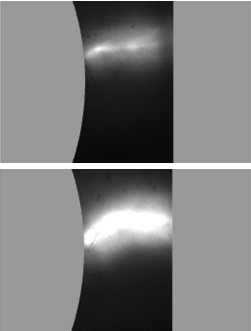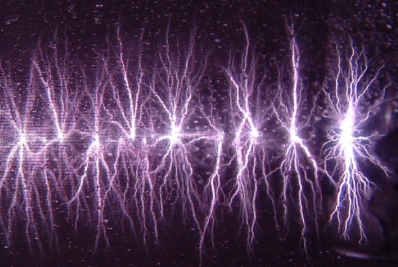Discharges in Water and Their Applications
 |
||
Breakdown development in water for a 400-μm gap. With positive biased pin, a single streamer bridges the gap in less than 10 ns. |
Electrical breakdown in liquids has been a research topic for well over a century. While the understanding of insulating liquids often strives to avoid the phenomenon,
especially water and other polar liquids are investigated with the goal to take advantage of the mechanism.
One prevalent application is the switching of high voltages. Closing switches that use water as switching medium excel through high hold-off voltages of and fast closing times. Either depends on the geometry of the switch and the hold-off time, i.e. for how long the voltage is applied. Switching voltages as high as 4 MV have been demonstrated and some configurations have shown switching times on the order of 1 ns.
Whereas electron avalanche ionization and streamer mechanisms were accepted within a few decades to explain the breakdown in gases, the nature of the breakdown in dielectric liquids is still disputed. In principle the dispute can be referred to two schools of thought. The first assumes the development of an initial gaseous phase, which then serves as the medium for avalanche development. Consequently, electrical breakdown in liquids is considered a 'shrouded gas discharge'. The alternate hypothesis states that a gaseous phase is not required and impact ionization in the liquid phase itself will result in a charge carrier multiplication, responsible for breakdown.
One prevalent application is the switching of high voltages. Closing switches that use water as switching medium excel through high hold-off voltages of and fast closing times. Either depends on the geometry of the switch and the hold-off time, i.e. for how long the voltage is applied. Switching voltages as high as 4 MV have been demonstrated and some configurations have shown switching times on the order of 1 ns.
Whereas electron avalanche ionization and streamer mechanisms were accepted within a few decades to explain the breakdown in gases, the nature of the breakdown in dielectric liquids is still disputed. In principle the dispute can be referred to two schools of thought. The first assumes the development of an initial gaseous phase, which then serves as the medium for avalanche development. Consequently, electrical breakdown in liquids is considered a 'shrouded gas discharge'. The alternate hypothesis states that a gaseous phase is not required and impact ionization in the liquid phase itself will result in a charge carrier multiplication, responsible for breakdown.
 |
||
Time integrated image of a streamer discharge generated in a water-filled coaxial reactor of 44 mm diameter, 100 mm length, and a tungsten-wire center electrode of 75 μm diameter. |
A major force, which is driving the interest in streamer discharges in water are the very promising applications for water purification. The potential of streamers for
the chemical and bacteriological decontamination stems from multiple interaction mechanisms that attack cells viruses and chemical contaminants alike. Four main agents
can be identified, which contribute, depending on target and ambient conditions, to varying degree to the efficacy of the treatment: strong electric fields in
particular at the streamer head, free radicals in particular hydroxyl and other oxidative species generated in the plasma, ultraviolet radiation from the plasma, and
shockwaves emanating from the discharge channel.
In our research we investigate conditions and mechanisms of electrical breakdown in water for the application of short pulses of nanosecond duration. This regime is of considerable interest in the design of pulse generators for a variety of applications ranging from inertial confinement fusion to the treatment of cancer. At the same time an understanding of the physical response of the medium under extreme conditions of electric field and pulse duration is extremely interesting and challenging. (For example not even the permittivity can be considered a constant any longer.)
In our research we investigate conditions and mechanisms of electrical breakdown in water for the application of short pulses of nanosecond duration. This regime is of considerable interest in the design of pulse generators for a variety of applications ranging from inertial confinement fusion to the treatment of cancer. At the same time an understanding of the physical response of the medium under extreme conditions of electric field and pulse duration is extremely interesting and challenging. (For example not even the permittivity can be considered a constant any longer.)
A second direction of our research is the use of streamer discharges (i.e. the "progress" of electrical breakdown) in water for water purification and waste
water treatment. As foremost physical attack agent, streamers are indiscriminate against biological and chemical agents and can be used against either of them
accordingly and simultaneously. The method does further not involve any additional chemicals and is as a non-thermal process (at least theoretically) very efficient.
For more details or information check out our publications or send me an email.